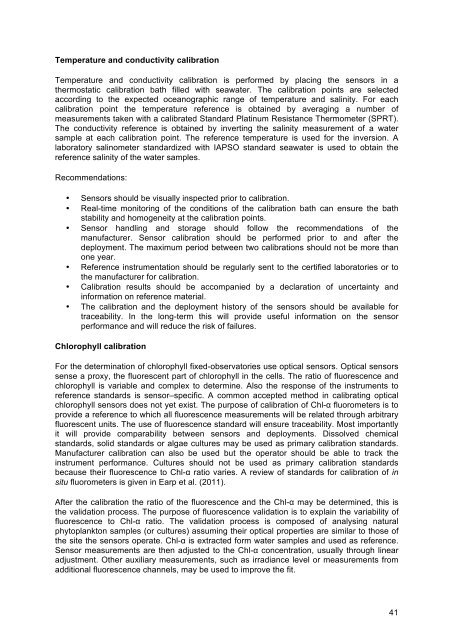Handbook of best practices
Handbook%20of%20best%20practices
Handbook%20of%20best%20practices
You also want an ePaper? Increase the reach of your titles
YUMPU automatically turns print PDFs into web optimized ePapers that Google loves.
Temperature and conductivity calibration<br />
Temperature and conductivity calibration is performed by placing the sensors in a<br />
thermostatic calibration bath filled with seawater. The calibration points are selected<br />
according to the expected oceanographic range <strong>of</strong> temperature and salinity. For each<br />
calibration point the temperature reference is obtained by averaging a number <strong>of</strong><br />
measurements taken with a calibrated Standard Platinum Resistance Thermometer (SPRT).<br />
The conductivity reference is obtained by inverting the salinity measurement <strong>of</strong> a water<br />
sample at each calibration point. The reference temperature is used for the inversion. A<br />
laboratory salinometer standardized with IAPSO standard seawater is used to obtain the<br />
reference salinity <strong>of</strong> the water samples.<br />
Recommendations:<br />
• Sensors should be visually inspected prior to calibration.<br />
• Real-time monitoring <strong>of</strong> the conditions <strong>of</strong> the calibration bath can ensure the bath<br />
stability and homogeneity at the calibration points.<br />
• Sensor handling and storage should follow the recommendations <strong>of</strong> the<br />
manufacturer. Sensor calibration should be performed prior to and after the<br />
deployment. The maximum period between two calibrations should not be more than<br />
one year.<br />
• Reference instrumentation should be regularly sent to the certified laboratories or to<br />
the manufacturer for calibration.<br />
• Calibration results should be accompanied by a declaration <strong>of</strong> uncertainty and<br />
information on reference material.<br />
• The calibration and the deployment history <strong>of</strong> the sensors should be available for<br />
traceability. In the long-term this will provide useful information on the sensor<br />
performance and will reduce the risk <strong>of</strong> failures.<br />
Chlorophyll calibration<br />
For the determination <strong>of</strong> chlorophyll fixed-observatories use optical sensors. Optical sensors<br />
sense a proxy, the fluorescent part <strong>of</strong> chlorophyll in the cells. The ratio <strong>of</strong> fluorescence and<br />
chlorophyll is variable and complex to determine. Also the response <strong>of</strong> the instruments to<br />
reference standards is sensor–specific. A common accepted method in calibrating optical<br />
chlorophyll sensors does not yet exist. The purpose <strong>of</strong> calibration <strong>of</strong> Chl-α fluorometers is to<br />
provide a reference to which all fluorescence measurements will be related through arbitrary<br />
fluorescent units. The use <strong>of</strong> fluorescence standard will ensure traceability. Most importantly<br />
it will provide comparability between sensors and deployments. Dissolved chemical<br />
standards, solid standards or algae cultures may be used as primary calibration standards.<br />
Manufacturer calibration can also be used but the operator should be able to track the<br />
instrument performance. Cultures should not be used as primary calibration standards<br />
because their fluorescence to Chl-α ratio varies. A review <strong>of</strong> standards for calibration <strong>of</strong> in<br />
situ fluorometers is given in Earp et al. (2011).<br />
After the calibration the ratio <strong>of</strong> the fluorescence and the Chl-α may be determined, this is<br />
the validation process. The purpose <strong>of</strong> fluorescence validation is to explain the variability <strong>of</strong><br />
fluorescence to Chl-α ratio. The validation process is composed <strong>of</strong> analysing natural<br />
phytoplankton samples (or cultures) assuming their optical properties are similar to those <strong>of</strong><br />
the site the sensors operate. Chl-α is extracted form water samples and used as reference.<br />
Sensor measurements are then adjusted to the Chl-α concentration, usually through linear<br />
adjustment. Other auxiliary measurements, such as irradiance level or measurements from<br />
additional fluorescence channels, may be used to improve the fit.<br />
41


